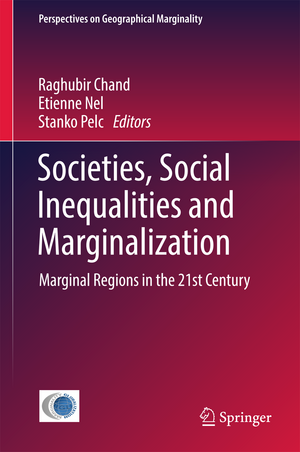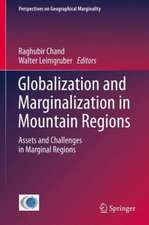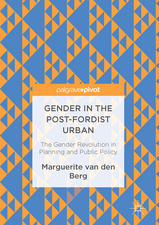Societies, Social Inequalities and Marginalization: Marginal Regions in the 21st Century: Perspectives on Geographical Marginality, cartea 2
Editat de Raghubir Chand, Etienne Nel, Stanko Pelcen Limba Engleză Hardback – 10 apr 2017
Though the book will be especially interesting for those looking
for insights into the situation and position of ethnic groups living in harsh mountainous conditions in the Himalayan region, examples from other parts of the world such as Kyrgyzstan, Israel, Switzerland and Finland provide an opportunity for comparison of marginality and marginalization from around the world. Also addressed are issues such as livelihood, outmigration and environmental threats, taking into account the conditions, scale and perspective of observation.
Throughout the text, particular attention is given to the context and concept of ‘marginalization’, which sadly remains a persistent reality of human life. It is in this context that this book seeks to advance our global understanding of what marginalization is, how it is manifested and what causes it, while also proposing remedial strategies.
| Toate formatele și edițiile | Preț | Express |
|---|---|---|
| Paperback (1) | 705.65 lei 3-5 săpt. | |
| Springer International Publishing – 8 mai 2018 | 705.65 lei 3-5 săpt. | |
| Hardback (1) | 709.25 lei 3-5 săpt. | |
| Springer International Publishing – 10 apr 2017 | 709.25 lei 3-5 săpt. |
Preț: 709.25 lei
Preț vechi: 834.41 lei
-15% Nou
Puncte Express: 1064
Preț estimativ în valută:
135.73€ • 147.38$ • 114.01£
135.73€ • 147.38$ • 114.01£
Carte disponibilă
Livrare economică 01-15 aprilie
Preluare comenzi: 021 569.72.76
Specificații
ISBN-13: 9783319509976
ISBN-10: 3319509977
Pagini: 316
Ilustrații: XIX, 311 p. 70 illus., 58 illus. in color.
Dimensiuni: 155 x 235 x 24 mm
Greutate: 0.76 kg
Ediția:1st ed. 2017
Editura: Springer International Publishing
Colecția Springer
Seria Perspectives on Geographical Marginality
Locul publicării:Cham, Switzerland
ISBN-10: 3319509977
Pagini: 316
Ilustrații: XIX, 311 p. 70 illus., 58 illus. in color.
Dimensiuni: 155 x 235 x 24 mm
Greutate: 0.76 kg
Ediția:1st ed. 2017
Editura: Springer International Publishing
Colecția Springer
Seria Perspectives on Geographical Marginality
Locul publicării:Cham, Switzerland
Cuprins
Chapter 1. Introduction (Raghubir Chand).- Part I: Poverty, social inequalities, marginalization and globalization.- Chapter 2. Marginality and marginalization (Stanko Pelc).- Chapter 3. Poverty and Global Warming: an Example of the Kyrgyz Republic (Asylbek A. Aidarliev).- Chapter 4. Socio-economic wellbeing and mental health profile of rural hill women of Uttarakhand, India (Lata Pande).- Chapter 5. The Status of Marginalized Women Tea Garden Workers in the Mountain ecosystem of Darjeeling in a Globalised Village (Moushumi Datta).- Chapter 6. Level of Socio-Economic Development in the Mountain Watershed of Uttarakhand State (India) (Savita Chauniyal).- The Tales of Origin and Settling Process of Marginal Societies in Bhutan (Aditi Chand).- Part II: Indigenous communities, identity, livelihood practices and biodiversity.- Chapter 8. Consequences of the Ottoman Land Law: Agrarian and Privatization Processes in Palestine, 1858-1918 (Ruth Kark).- Chapter 9. Negev Bedouin and Indigenous People: A Comparative Review (Havazelet Yahel).- Chapter 10. Changing Identity, livelihood and Biodiversity of Indigenous Communities in The Eastern Himalaya with special reference to Aka Tribe (Gibji Nimasow).- Chapter 11. The changing socio-economic profile of the Shokas and Rangs vis-à-vis the loss of agro-diversity, and the exploitation of Yartsa Gunbu (the caterpillar mushroom): A case study of the Askote Conservation Landscape, district Pithoragarh, Kumaun Himalaya (Chandra Singh Negi).- Chapter 12. Brokpa Yak Herders of Bhutan: A Study in Pastoral Livelihood Patterns, Transhumance and “drukor” (Raghubir Chand).- Chapter 13. Occupational Diversification and Changing Marginality conditions of Brokpas of Bhutan in Twenty First Century (Raghubir Chand).- Chapter 14. Socio-Cultural and Nutritional Environment of a Marginal Community of Uttarakhand—A Case Study of Tharu Tribe (B. R. Pant).- Part III: Migration, depopulation and environmental fragility.- Chapter 15. Similarity of the Spatial Patterns of Net Migration and Unemployment in Finland (Olli Lehtonen).- Chapter 16. Regional Pattern of Migration Flows in Uttarakhand, India (R.C.S. Taragi).- Part IV: Policies and strategies.- Chapter 17. Tourism In the Swiss Alps: the human factor in local development (Walter Leimgruber).- Chapter 18. Garhwal Himalaya - Potential of Cash Crops in Attaining Food Security and Enhancing Livelihoods - Khanda Gad Watershed case study (Vishwambhar Prasad Sati.
Notă biografică
Raghubir Chand’s primary research interests are in mountain geography with regard to the Himalayan environment and landscape ecology, socio-economic and demographic transformation of Himalayan societies, migration studies, agricultural productivity, cultural geography, environmental and livelihood support systems of tribal communities of Bhutan and other parts of the western Himalayas. He has published three books including Brokpas: The Himalayan Highlanders of Bhutan (2004) and Globalization and Marginalization in Mountain Regions (Springer, 2016). He has published 80 papers in various national and international journals. Further, he serves on the editorial board and is one of the founder members of PAHAR—a research journal of the People’s Association for Himalaya Area Research based in Nainital, India.
Etienne Nel has research interests in regional, local and community economic development. He is currentl
y the Managing Editor of the journal New Zealand Geographer and the Commissioning Editor for the journals Local Economy and Journal of Geography in Higher Education. He has edited/authored eight books and is currently engaged in two book projects with Routledge. Stanko Pelc has been involved in rural development and planning of transportation systems; at present, he teaches at the geography department as well as at the departments of pre-school and primary education. His research interests cover many different fields such as demography, transportation geography, local and regional development, marginality and marginalization, especially its social dimension and in the educational context. He has edited two books; he is the author of one book and one university textbook (all in Slovenian) and has contributed several chapters to books in English/German. He has recently published an online book about Slovenia’s urban population.
Etienne Nel has research interests in regional, local and community economic development. He is currentl
y the Managing Editor of the journal New Zealand Geographer and the Commissioning Editor for the journals Local Economy and Journal of Geography in Higher Education. He has edited/authored eight books and is currently engaged in two book projects with Routledge. Stanko Pelc has been involved in rural development and planning of transportation systems; at present, he teaches at the geography department as well as at the departments of pre-school and primary education. His research interests cover many different fields such as demography, transportation geography, local and regional development, marginality and marginalization, especially its social dimension and in the educational context. He has edited two books; he is the author of one book and one university textbook (all in Slovenian) and has contributed several chapters to books in English/German. He has recently published an online book about Slovenia’s urban population.
Textul de pe ultima copertă
This book provides an overview of marginality or marginalization, as a concept, characterizing a situation of impediments – social, political, economic, physical, and environmental – that impact the abilities of many people and societies to improve their human condition. It examines a wide range of examples and viewpoints of societies struggling with poverty, social inequality and marginalization.
Though the book will be especially interesting for those looking for insights into the situation and position of ethnic groups living in harsh mountainous conditions in the Himalayan region, examples from other parts of the world such as Kyrgyzstan, Israel, Switzerland and Finland provide an opportunity for comparison of marginality and marginalization from around the world. Also addressed are issues such as livelihood, outmigration and environmental threats, taking into account the c
onditions, scale and perspective of observation.
Throughout the text, particular attention is given to the context and concept of ‘marginalization’, which sadly remains a persistent reality of human life. It is in this context that this book seeks to advance our global understanding of what marginalization is, how it is manifested and what causes it, while also proposing remedial strategies.
Though the book will be especially interesting for those looking for insights into the situation and position of ethnic groups living in harsh mountainous conditions in the Himalayan region, examples from other parts of the world such as Kyrgyzstan, Israel, Switzerland and Finland provide an opportunity for comparison of marginality and marginalization from around the world. Also addressed are issues such as livelihood, outmigration and environmental threats, taking into account the c
onditions, scale and perspective of observation.
Throughout the text, particular attention is given to the context and concept of ‘marginalization’, which sadly remains a persistent reality of human life. It is in this context that this book seeks to advance our global understanding of what marginalization is, how it is manifested and what causes it, while also proposing remedial strategies.
Caracteristici
Advances and refines the concept of marginality Reveals different examples of societies living in marginal conditions and the variable impacts of globalization Features case studies mainly from the Himalayan region on a wide range of topics that reveal different perspectives on marginality and marginalization Includes supplementary material: sn.pub/extras




























